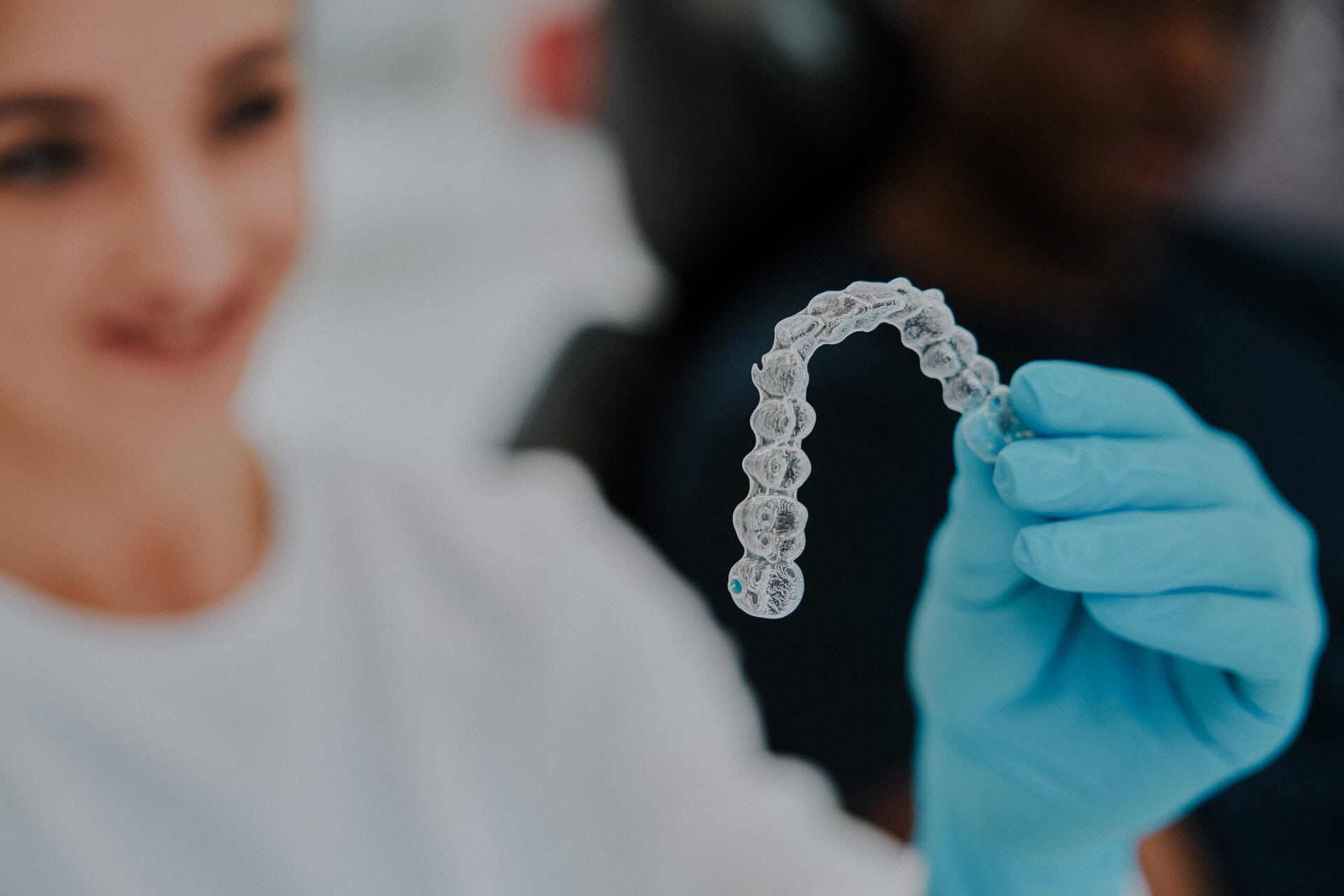Menu
Free Consultation

Many patients fear receiving orthodontic treatment due to the noticeable look of traditional metallic braces. However, clear braces are a discreet solution designed to straighten teeth with transparent or tooth-colored materials that blend naturally with your smile. As a result, this alternative has proven its place as one of the most requested braces for teens and adults who value aesthetics.
This short guide explores what clear braces are, their benefits, costs, maintenance tips, and what to expect during treatment to help you decide if they’re the right choice for you.
Clear braces are orthodontic devices made from ceramic or transparent materials designed to straighten misaligned teeth while blending with your natural dentition. They work like traditional metal braces, but without the metal wires that you’re used to seeing in conventional treatment. Therefore, clear aligners are less noticeable and a highly valuable alternative for every image-conscious patient.
Clear braces work by applying consistent, gentle, and controlled pressure to teeth, gradually moving them into the desired position over time. Just like conventional braces, this orthodontic treatment also requires brackets bonded to each tooth and connected by a tooth-colored archwire to minimize visibility. Then, your specialist periodically adjusts this wire to guide your teeth into alignment.
This type of brace is ideal for patients seeking effective orthodontic treatment without the metallic appearance of traditional braces. Although they’re highly discreet, they still provide the same level of control and precision as standard metallic braces, making them suitable for mild to complex orthodontic cases.
While traditional metal braces are widely known for their durability and effectiveness, they can be very noticeable. Contrarily, clear braces provide similar orthodontic results with a less conspicuous appearance. Thus, they are often preferred by adults and professionals who want to correct their smile without drawing too much attention to the treatment.
On the other hand, clear braces may require more meticulous cleaning to prevent ceramic staining. Also, they can be slightly more fragile when compared to metal braces, which might influence treatment time if you need repairs or replacements.
Clear braces are fixed and bonded to the teeth’s surface, while clear aligners, like Invisalign, are removable. Also, although aligners offer flexibility and comfort, they require strict compliance from the patient to obtain the expected results.
Additionally, clear braces provide constant and controlled pressure that adapts to almost every case, while clear aligners work best in mild to moderate cases. However, your orthodontist will recommend the best option based on your needs and expectations.
Clear braces are suitable for most patients, including adults and teenagers with one or multiple of the following conditions:
However, they may not be the best choice for people with severe bite conditions that require more aggressive corrections, or for those with staining habits like severe smoking or heavy coffee consumption without the appropriate cleaning.
The cost of clear braces varies depending on multiple factors, such as:
In the United States, the price of clear braces typically ranges from $3,500 to $8,000, while in Latin America, it may be lower due to differences in the healthcare system and overhead expenses.
Usually, dental insurance covers part of the cost if braces are deemed medically necessary. Also, while many orthodontic practices also offer payment plans to make the treatment more affordable, it is crucial to ask about all potential fees, exams, taxes, consultations, repairs, adjustments, and post-treatment retainers.
The more severe the condition, the higher the cost of the procedure. Also, highly complex misalignment may require longer treatments and more frequent adjustments to achieve the best results.
A highly experienced specialist will probably cost more than an inexperienced professional. However, the experience comes with more efficient and predictable results.
Premium ceramic brackets typically cost more than standard metallic ones as they’re less frequent and more expensive to make.
Brackets cannot be placed over decayed or damaged teeth. As a result, the specialist must deal with decay, gum disease, fractures, and every other dental issue before starting the procedure.
While it may have some variations, the process of getting clear braces typically involves:
Oral hygiene is essential while wearing clear braces to prevent staining and maintain gum health. Here you have some practical tips to implement in your home routine:
Also, avoid sticky, hard, or prone-to-staining foods, such as coffee, red wine, curry, and dark sodas. If you cannot or want to reduce them, then consider rinsing and brushing as soon as possible.
Q. How much do clear braces cost?
In the U.S., they can range from $3,500 to $8.000. However, the cost may be lower in other regions and even between states.
Q. Are clear braces as effective as metal braces?
Yes, they can be as effective as metal braces for most cases. Yet, they require careful maintenance to avoid damage or staining.
Q. What foods should I avoid with clear braces?
Avoid sticky, hard, or chewy food like caramels, nuts, chewing gum, and popcorn. Avoiding staining foods and drinks can also help reduce the chances of staining while extending the life of your brackets.
Q. How long will I need to wear my retainer after the treatment?
Most patients need to wear their retainers full-time for the first months and then transition to nighttime use indefinitely. These retainers help maintain your results and prevent the famous orthodontic relapse.
Q. What happens if I don’t use my retainers?
Skipping orthodontic retainers makes your teeth relapse to their original positions. Therefore, periodic checkups and patient compliance are essential to achieve and keep great results.
Clear braces are an excellent solution for those who want the effectiveness of conventional treatment without the metallic look. While they typically require a higher level of care to prevent staining and damage, they provide great results that also boost confidence by providing a discreet appearance. As a result, many patients with complex orthodontic cases opt for this alternative to transform their smiles.
